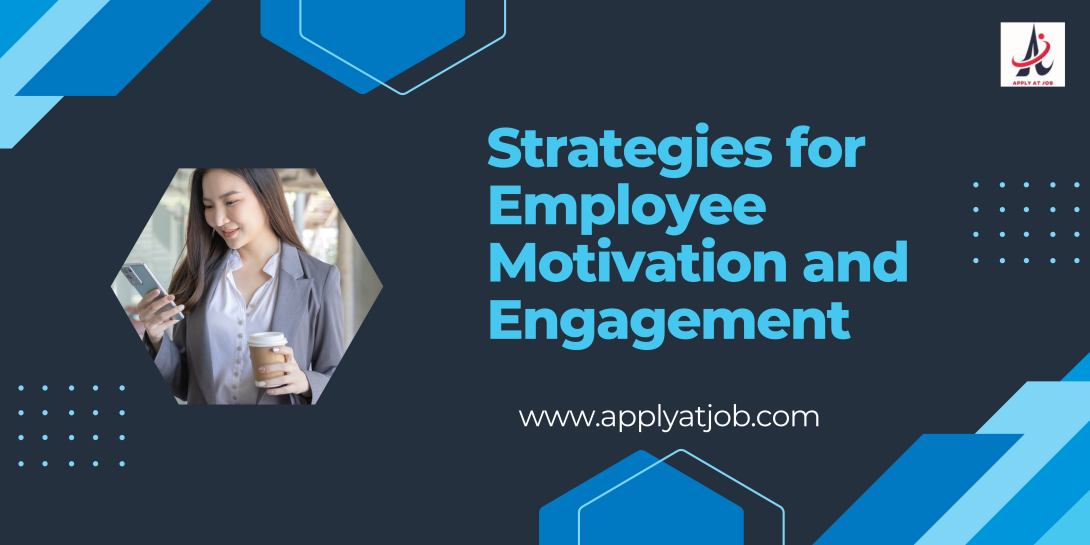
Techniques for Increasing Employee Engagement and Motivation:
The motivation and engagement of employees are critical elements that influence a business's success. Employees that are focused, committed, and productive are more likely to make a good impact on the company. Conversely, undermotivated workers may result in lower output, greater rates of employee turnover, and a general drop in morale at work. In this blog, we'll look at a variety of tactics managers and other leaders may do to increase staff engagement and motivation and foster an atmosphere where people are motivated to give their all at work.
1. Recognize the Motivations of Your Staff:
Different things encourage each employee in a different way. While some people can be motivated by money, others might be inspired by the chance to improve themselves, get notoriety, or make a significant contribution to society. Developing a successful engagement plan starts with knowing what motivates each member of the team.
Action Items:
. Find out what drives your staff members by conducting surveys or one-on-one conversations. Inquire about their objectives, desired careers, and workplace values.
. Make sure that awards and recognition are tailored to each employee's preferences so that they feel valued in the ways that are important to them.
Benefits:
By understanding your workers' individual motivators, you can adjust your strategy to suit their requirements and promote a more engaged and driven staff.
2. Encourage transparent and open communication:
Communication that is honest and open is essential to employee engagement. Workers desire to be appreciated, heard, and informed about organizational developments. Employees are more likely to have a sense of purpose and trust the leadership when there is clear and open communication.
Steps to Take:
. Schedule frequent team meetings to discuss firm developments, objectives, and difficulties. Encourage staff members to offer comments and pose questions.
. Provide an open-door policy so that staff members may approach management with suggestions or grievances without worrying about criticism or retaliation.
Benefits:
Clear communication fosters a culture of trust between management and staff, making everyone feel important and invested in the company's goals. Workers are more likely to be motivated and engaged when they feel heard.
3. Offer chances for expansion and improvement:
When workers see that there are prospects for advancement inside the company, their likelihood of remaining engaged is increased. While employees who are not learning continuously are not as motivated and focused on their work and personal objectives, stagnation can result in boredom and disengagement.
Action Steps:
. Provide staff with chances for mentoring, workshops, or training programs to assist them grow professionally.
. Give them access to online courses, certificates, and industry conventions to promote lifelong learning.
Benefits:
Offering growth chances encourages workers to stay loyal while also pushing them to do better. Employee engagement and commitment to the company are higher when they perceive a clear route for promotion.
4. Honor and Celebrate Success:
One of the most effective incentives at work is recognition. Employees are more likely to remain engaged and motivated when they believe that their efforts are valued. Incentives can take many different forms, such as cash bonuses, public recognition, or even little messages of gratitude.
Action Steps:
. Establish a program for employee appreciation that periodically showcases both individual and group accomplishments.
. Publicly recognize and celebrate accomplishments, whether via company-wide emails, recognition walls, or team meetings.
. Provide incentives that are both monetary and non-monetary, such bonuses, more time off, or handcrafted presents.
Benefits:
Rewarding excellent conduct consistently encourages staff members to keep aiming for greatness. Additionally, it fosters a healthy work atmosphere where staff members experience worth and appreciation.
5. Encourage a work-life balance:
Sustaining employee motivation and well-being requires a positive work-life balance. Workers that are overworked are more likely to burn out, which can result in a drop in production and disengagement. Allowing workers to live a balanced lifestyle with flexibility and assistance makes it easier for them to combine their home and work lives.
Next Steps:
. Provide employees with opportunities for remote work or flexible work schedules so they may manage their obligations outside of work.
. Encourage staff members to take breaks and time off so they may refuel so they can come back to work with more vigor and concentration.
. Encourage the implementation of wellness activities including counseling services, exercise regimens, and mental health days.
Benefits:
Encouraging work-life balance shows your staff that you are concerned about their welfare, which encourages engagement and loyalty over the long run. A well-rounded workforce is less prone to have stress-related problems and is more creative and productive.
6. Give Workers a Sense of Independence:
Employee disengagement can result from micromanagement, which can impede motivation and innovation. Granting employees autonomy over their duties and responsibilities fosters a sense of ownership over their work and increases their self-confidence.
Action Steps:
. Give workers the flexibility to handle their job without continual supervision by assigning them assignments and letting them make decisions about their roles.
. Promote initiative among staff members by giving them the chance to take the lead on projects or offer suggestions for how to streamline procedures.
Advantages:
Employees who feel in charge of their job are more engaged and driven to achieve because they feel more trusted and empowered.
Conclusion:
Any organization's ability to succeed depends on its ability to motivate and engage its workforce. You can build an atmosphere where people flourish by learning about what motivates them, encouraging open communication, offering growth opportunities, recognizing accomplishments, encouraging work-life balance, empowering autonomy, and establishing a good work culture. Putting these techniques into practice will not only increase individual performance but also raise team morale, lower employee turnover, and add to the company's long-term success. Your most valuable resource is your motivated and engaged workforce; invest in them, and they will invest in your company.




